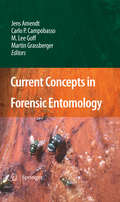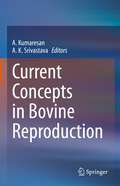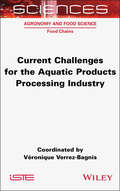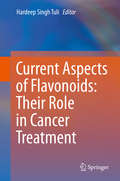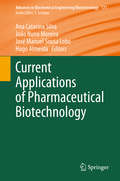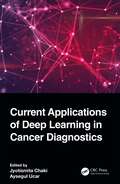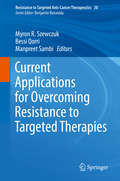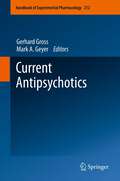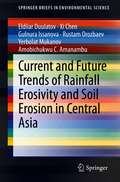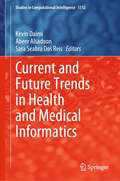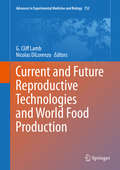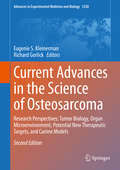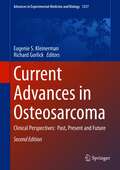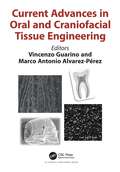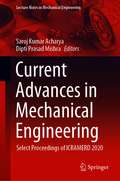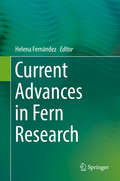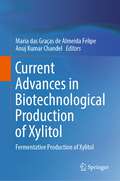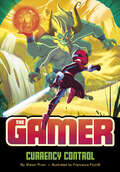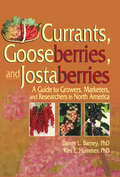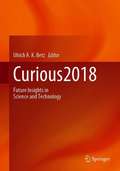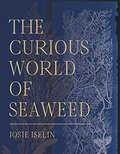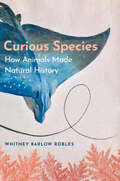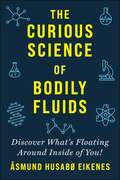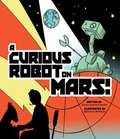- Table View
- List View
Current Concepts in Forensic Entomology
by Carlo P. Campobasso M. Lee Goff Martin Grassberger Jens AmendtTwenty years ago the use of entomology in a crime scene investigation was considered bizarre, despite the solid scientific background and documented historical applications. Today, the use of insect evidence is an accepted sub-discipline in modern forensic science. Nevertheless, forensic entomology is still growing and remains a living scientific discipline with many branches. The present book highlights this diversity by collecting contributions dealing with novel aspects, for example, marine biology, chemical ecology and acarology, as well as the basic disciplines like entomotoxiciology and decomposition. It also offers keys for immature insects, discussions of important pitfalls and introductions to the statistical evaluation of data sets. Many topics are covered in depth for the first time. All the authors are leading experts in their respective fields of research. Their chapters show directions for future research for both new and veteran forensic entomologists. Undoubtedly, forensic entomology will continue to grow and attract new professionals, students, as well as interested observers. This book is written for all of them.
Current Concepts in Bovine Reproduction
by A. Kumaresan A. K. SrivastavaThis book provides updated information on the current concepts in bovine reproduction. It describes the complex issues associated with fertility and infertility in bovines and suggests strategies for achieving high reproductive efficiency. It discusses topics related to the fertility trend in bovines, estrus detection, controlled breeding, postpartum uterine health, uterine infections, and its therapeutic management. The essential roles of metabolic hormones on gonadal functions and fertility are also covered. Additionally, the book presents new insights in maternal recognition of pregnancy in bovines and suggest nutritional strategies to improve reproductive efficiency. The chapters on male fertility provide current information on semen cryopreservation, sperm quality assessment and measures to improve sperm fertility. A special chapter on intricacies in buffalo semen cryopreservation and measures to improve the quality of cryopreserved sperm is also included in this book. Lastly, the book introduces the immunobiological roles of anti-microbial peptides during sperm transport in reproductive tract and epigenetic bearing on fertility. This book is an invaluable resource for veterinary scientists, students and practitioners to understand the current developments in bovine reproduction for improving reproductive efficiency.
Current Challenges for the Aquatic Products Processing Industry
by Véronique Verrez-BagnisThis book offers a state-of-the-art analysis on the main challenges facing the aquatic products processing industry. The topics explored are particularly relevant to the issues faced by European consumers and processors, but the information provided within this book can be widely extrapolated. This book should be helpful for processors, fish traders, consumers, scientists and students. The first chapter is dedicated to the sociological definition of "fish" and consumers’ perceptions. The following chapters deal with the notions of quality sensu lato, biological risks and their control, as well as the risks linked to the pollution of oceans and ecosystems by microplastics. Two types of processes and processed products – smoked fish and surimi products – which are of great economic importance to the European market, are also presented. The process of adding value to co-products, including the "blue biorefinery" and the innovative pH-shift technology are also covered in this book.
Current Aspects of Flavonoids: Their Role in Cancer Treatment
by Hardeep Singh TuliThe book comprehensively introduces readers to various aspects of flavonoids, a category of natural metabolites that exhibits various pharmacological effects. It discusses their chemistry, absorption and metabolism, mechanisms of action and toxicology as well as future perspectives for clinical applications, and also provides detailed insights into their anti-cancer properties, since flavonoids are known to modulate tumor-associated intracellular as well as extracellular signaling pathways. The book also highlights the current research on the health effects of selected flavonoids, and their various roles in cancer prevention and treatment. Lastly, the book elucidates nanotechnology-mediated tools to enhance the bioavailability and solubility of flavonoids to improve their bioactivity and pharmacokinetic parameters.
Current Applications of Pharmaceutical Biotechnology (Advances in Biochemical Engineering/Biotechnology #171)
by Ana Catarina Silva João Nuno Moreira José Manuel Sousa Lobo Hugo AlmeidaThis book offers an authoritative review of biopharmaceuticals and their clinical relevance. Biopharmaceuticals have been showing high therapeutic potential by means of biological and biosimilar medicines, particularly for the treatment of cancer, chronic diseases (e.g. diabetes, Crohn's disease, psoriasis and rheumatoid arthritis), neurodegenerative disorders (e.g. multiple sclerosis), and they have also been contributing to the progress of innovative therapies such as assisted reproductive medicine. Since the eighties, several biopharmaceuticals have been approved and, due to patents expiration, many biosimilars are also marketed.In this book, readers will find the most relevant updated information about the main clinical applications of pharmaceutical biotechnology. The authors provide expert analysis about the industrial challenges of recombinant proteins and the different classes of biopharmaceuticals, including monoclonal antibodies, vaccines, growth factors and stem cells. Topics such as bioprinting technologies in tissue engineering, gene therapy and personalized medicine are also covered in this book. Professionals, students and researchers interested in this field will find this work an important account.
Current Applications of Deep Learning in Cancer Diagnostics
by Jyotismita Chaki Aysegul UcarThis book examines deep learning-based approaches in the field of cancer diagnostics, as well as pre-processing techniques, which are essential to cancer diagnostics. Topics include introduction to current applications of deep learning in cancer diagnostics, pre-processing of cancer data using deep learning, review of deep learning techniques in oncology, overview of advanced deep learning techniques in cancer diagnostics, prediction of cancer susceptibility using deep learning techniques, prediction of cancer reoccurrence using deep learning techniques, deep learning techniques to predict the grading of human cancer, different human cancer detection using deep learning techniques, prediction of cancer survival using deep learning techniques, complexity in the use of deep learning in cancer diagnostics, and challenges and future scopes of deep learning techniques in oncology.
Current Applications for Overcoming Resistance to Targeted Therapies (Resistance to Targeted Anti-Cancer Therapeutics #20)
by Myron R. Szewczuk Bessi Qorri Manpreet SambiTargeted therapies were initially developed to exploit the upregulation and dependence on key oncogenic pathways critical to cancer progression. Additionally, they also presented as a method to overcome chemoresistance by supplementing conventional therapeutic regimens with targeted therapies. However, the development of resistance to these combinatorial approaches has led to the reassessment of currently available therapeutic options to overcome resistance to targeted therapy. This book aims to provide an update on the advancements in the therapeutic arms race between cancer, clinicians and scientists alike to overcome resistance to targeted therapies. Subject experts provide a comprehensive overview of the challenges and solutions to resistance to several conventional targeted therapies in addition to providing a discussion on broad topics including targeting components of the tumor microenvironment, emerging therapeutic options, and novel areas to be explored concerning nanotechnology and the epigenome.
Current Antipsychotics (Handbook of Experimental Pharmacology #212)
by Gerhard Gross Mark A. GeyerSix decades after the serendipitous discovery of chlorpromazine as an antipsychotic and four decades after the launch of clozapine, the first atypical or second generation antipsychotic, psychopharmacology has arrived at an important crossroad. It is clear that pharmacological research and pharmaceutical development must now focus on complementary or even alternative mechanisms of action to address unmet medical needs, i.e. poorly treated domains of schizophrenia, improved acceptance by patients, better adherence to medication, safety in psychoses in demented patients, and avoiding cardiac and metabolic adverse effects. The first completely novel mechanisms evolving from our insights into the pathophysiology of psychotic disorders, especially the role of glutamatergic mechanisms in schizophrenia, are now under development, and further principles are on the horizon. This situation, in many respects similar to that when the initial second-generation antipsychotics became available, can be rewarding for all. Preclinical and clinical researchers now have the opportunity to confirm their hypotheses and the pharmaceutical industry may be able to develop really novel classes of therapeutics. When we were approached by the publishers of the Handbook of Experimental Pharmacology to prepare a new volume on antipsychotics, our intention was to capture both, the accumulated preclinical and clinical knowledge about current antipsychotics as well as prospects for new and potentially more specific antischizophrenia principles. These efforts should be based on the pathophysiology of the diseases and the affected neurotransmitter systems. Since preclinical research on antipsychotic compounds is only reliable when intimately linked through translational aspects to clinical results, we decided to include clinical science as well. It turned out that that this endeavor could not be covered by a single volume. We thank the editorial board and the publishers for supporting our decision to prepare two volumes: Current Antipsychotics and Novel Antischizophrenia Treatments. These topics cannot really be separated from one another and should be seen as a composite entity despite the somewhat arbitrary separation of contributions into two volumes. The continuing challenges of developing improved and safer antipsychotic medications remain of concern and are discussed in the first volume. The new opportunities for the field to develop and license adjunctive treatments for the negative symptoms and cognitive deficits that are treated inadequately by existing compounds have been incentivized recently and provide the focus for the second volume. We hope these collective contributions will facilitate the development of improved treatments for the full range of symptomatology seen in the group of schizophrenias and other major psychotic disorders. Gerhard Gross, Ludwigshafen, Germany Mark A. Geyer, La Jolla, CA This volume will try to put current therapy - achievements, shortcomings, remaining medical needs - and emerging new targets into the context of increasing knowledge regarding the genetic and neurodevelopmental contributions to the pathophysiology of schizophrenia. Some of the chapters will also deal with respective experimental and clinical methodology, biomarkers, and translational aspects of drug development. Non-schizophrenia indications will be covered to some extent, but not exhaustively.
Current and Future Trends of Rainfall Erosivity and Soil Erosion in Central Asia (SpringerBriefs in Environmental Science)
by Eldiiar Duulatov Xi Chen Gulnura Issanova Rustam Orozbaev Yerbolat Mukanov Amobichukwu C. AmanambuThis book analyses climate change influences on rainfall erosivity and soil erosion across Central Asia, provides an overview (past and projections) on the Central Asian countries where projected changes in rainfall erosivity and erosivity density are the greatest, and discusses the potential impacts on the environment across the region. This analysis is accomplished primarily using the RUSLE model with past and future climate projections, spatiotemporal variations of rainfall erosivity and soil erosion based on WorldClim, and Coupled Model Intercomparison Project Phase 5 (CMIP5) climate models (for Central Asia and separately Kazakhstan). The relationship between precipitation characteristics and erosion has been well established, but spatial and temporal projections of future rainfall erosivity in a changing climate in Central Asia have not been published significantly. Therefore, assessing rainfall erosivity and its consequences can assist specialists and researchers in achieving the best practices for soil conservation. The result of this type of research is all-encompassing, and may reflect normal variations in other parts of the world (for example, the arid and semi-arid regions) and is inherently limited to the Central Asian region.
Current and Future Trends in Health and Medical Informatics (Studies in Computational Intelligence #1112)
by Kevin Daimi Abeer Alsadoon Sara Seabra Dos ReisThis book is comprehensive with most of its contents following the recommendations of international health and medical informatics associations and societies. To this extent it covers the areas of healthcare and medical information systems, management of healthcare and medical information systems, healthcare/medical information systems supporting patients and the public, healthcare/medical networking and care sharing, medical imaging and 3D/4D surgical visualization, design and analysis of health/medical records, health/medical data representation and analysis, simulation and modeling in healthcare, and health and medical informatics education.The book provides an excellent professional development resource for educators and practitioners on the state-of-the-art Health and Medical Informatics. It covers many areas and topics of Health and Medical Informatics and contributes toward the enhancement of the community outreach and engagement component of Health and Medical Informatics. Various techniques, methods, and approaches adopted by Health and Medical Informatics experts in the field are introduced. Furthermore, it provides detailed explanation of the Health and Medical Informatics concepts that are aptly reinforced by applications and some practical examples and a road map of future trends that are suitable for innovative Health and Medical Informatics.
Current and Future Reproductive Technologies and World Food Production (Advances in Experimental Medicine and Biology #752)
by G. Cliff Lamb Nicolas DilorenzoThis book addresses the impacts of current and future reproductive technologies on our world food production and provides a significant contribution to the importance of research in the area of reproductive physiology that has never been compiled before. It would provide a unique opportunity to separate the impacts of how reproductive technologies have affected different species and their contributions to food production. Lastly, no publication has been compiled that demonstrates the relationship between developments in reproductive management tools and food production that may be used a reference for scientists in addressing future research areas. During the past 50 years assisted reproductive technologies have been developed and refined to increase the number and quality of offspring from genetically superior farm animal livestock species. Artificial insemination (AI), estrous synchronization and fixed-time AI, semen and embryo cryopreservation, multiple ovulation and embryo transfer (MOET), in vitro fertilization, sex determination of sperm or embryos, and nuclear transfer are technologies that are used to enhance the production efficiency of livestock species.
Current Advances in the Science of Osteosarcoma: Research Perspectives: Tumor Biology, Organ Microenvironment, Potential New Therapeutic Targets, and Canine Models (Advances in Experimental Medicine and Biology #1258)
by Eugenie S. Kleinerman Richard GorlickThis thoroughly revised second edition is an up-to-date overview of the new advances in the knowledge of the basic science in sarcoma and osteosarcoma. It features detailed, in-depth discussions of microRNAs in osteosarcoma, historical perspectives of chemotherapy in the treatment of the disease, tumor targeted IL12 therapy and HER2 targeted therapy, the role of enhancer elements in regulating the prometastatic transcriptional program and more. Further, this essential volume also includes new insights on Wnt signaling in osteosarcoma, the role of genomics, genetically modified T-cell therapy, liquid biopsy, oncolytic viruses, immunophenotyping, receptor tyrosine kinases and epigenetic-focused approaches for treatment of osteosarcoma metastases, as well as thoughts on the current standard of treatment for patients suffering from these cancers. In the years since the previous edition, there have been numerous new developments in this rapidly changing field; this new edition is both timely and urgently needed. When taken together these companion volumes, Current Clinical (Book 1) and Scientific (Book 2) Advances in Osteosarcoma, are a timely and urgently needed guide for laboratory investigators and clinical oncologists.
Current Advances in Osteosarcoma: Clinical Perspectives: Past, Present and Future (Advances in Experimental Medicine and Biology #1257)
by Eugenie S. Kleinerman Richard GorlickThis thoroughly revised second edition complied in 2 books is an up-to-date overview of the current clinical advances in sarcoma and osteosarcoma. The new edition features detailed, in-depth discussions of microRNAs in osteosarcoma, historical perspectives of chemotherapy in the treatment of the disease, tumor targeted IL12 therapy and HER2 targeted therapy, the role of enhancer elements in regulating the prometastatic transcriptional program and more. Further, these essential volumes also includes new insights on Wnt signaling in osteosarcoma, the role of genomics, genetically modified T-cell therapy, liquid biopsy, oncolytic viruses, immunophenotyping, receptor tyrosine kinases and epigenetic-focused approaches for treatment of osteosarcoma metastases, as well as thoughts on the current standard of treatment for patients suffering from these cancers. In the years since the previous edition, there have been numerous new developments in this rapidly changing field; this new edition is both timely and urgently needed. When taken together these companion volumes, Current Clinical (Book 1) and Scientific (Book 2) Advances in Osteosarcoma, are a timely and urgently needed guide for laboratory investigators and clinical oncologists focused in sarcoma.
Current Advances in Oral and Craniofacial Tissue Engineering
by Vincenzo Guarino and Marco Antonio Alvarez-PérezOral tissue engineering involves the study of current approaches for in vitro regeneration of soft and hard tissues located into the oral cavity. In this context, recent approaches involves the use of innovative biomaterials to replace the lost or damaged human oral tissues. Recent discoveries in materials science and nanotechnology are drastically changing the traditional approach to dentistry by the design of innovative devices able more efficiently supporting the natural regeneration process. The objective of this book is to highlight current progress in tissue engineering for various dental hard/soft tissues including enamel, dentin, pulp, alveolar bone, periodontium, gum and oral mucosa, by emphasizing the role of materials and their specific applications.
Current Advances in Mechanical Engineering: Select Proceedings of ICRAMERD 2020 (Lecture Notes in Mechanical Engineering)
by Saroj Kumar Acharya Dipti Prasad MishraThis book presents select proceedings of the International Conference on Recent Advances in Mechanical Engineering Research and Development (ICRAMERD 2020). The contents focus on latest research and current problems in various branches of mechanical engineering. Some of the topics discussed here include fracture and failure analysis, fuels and alternative fuels, combustion and IC engines, advanced manufacturing technologies, powder metallurgy and rapid prototyping, industrial engineering and automation, supply chain management, design of mechanical systems, vibrations and control engineering, automobile engineering, fluid mechanics and machines, heat transfer, composite materials, micro and nano-engineering for energy storage and conversion, and modeling and simulations. The wide range of topics presented in this book can make it useful for beginners, researchers as well as professionals in mechanical engineering.
Current Advances in Fern Research
by Helena FernándezFerns, collectively, represent an ancient species of vascular plant which has a direct connection to the beginning of life on Earth. Today they are valued for their ornamental appeal, environmental benefit or as sources of health benefiting metabolites. Current pteridology, the study of fern, encompasses a wide range of research activities including, but not limited to, plant physiology, stress tolerance, genetics and genomics. The goal of this book is to compile the most relevant research done with ferns during the last decade. It is organized into four parts: I, Biology and Biotechnology; II, Evolution and Conservation; III, Metabolism and Genetic Resources, and IV, Environment. Each section reveals the utilization of ferns as a tool to explore challenges unique to plant development and adaptation.This project represents our collective effort to raise the awareness of ferns as a model system to study higher plant functions. Among the distinctive features of our proposed book are: (i) a wide range of topics with contributing researchers from all around the world, and (ii) recent advances of theoretic and applied knowledge with implications to crop species of economic value.
Current Advances in Biotechnological Production of Xylitol: Fermentative Production of Xylitol
by Maria das Graças de Almeida Felipe Anuj Kumar ChandelThis book explores recent advances in the microbial production of xylitol and its applications in food and medical sector. Xylitol is an important biomolecule from lignocellulose biorefinery which is produced from the xylose by chemical reactions or microbial fermentation methods. Currently, the demand of xylitol at commercial scale is being met through chemical methods. However, recent breakthroughs made in plant cell wall destruction, genetic engineering to develop the designer microorganisms, fermentation methods and media formulations and downstream processing have led the ways for sustainable production of xylitol at commercial scale in lignocellulose biorefineries. Microbial production of xylitol is preferred over the chemical processes as it is environmentally friendly, higher process efficiency with the desired product yield, and product recovery with minimum impurities. This book is a unique compilation of 11 book chapters written by experts in their respective fields. These chapters present critical insights and discuss the current progress and future progress in this area into fermentative xylitol production.Chapter 9 is licensed under the terms of the Creative Commons Attribution 4.0 International License. For further details see license information in the chapter.
Currency Control (The Gamer)
by Shawn PryorEvil Cynthia Cyber is robbing banks with her latest creation, a villain named Currency. The stolen money will go toward building a machine that can capture people in a simulation program. There she could control every victim’s life. It's up to the Gamer to stop Cynthia Cyber from taking over the world!
Currants, Gooseberries, and Jostaberries: A Guide for Growers, Marketers, and Researchers in North America
by Kim Hummer Danny BarneyRediscover the economic potential of growing Ribes cultivars in the United States and Canada! Currants, Gooseberries, and Jostaberries: A Guide for Growers, Marketers, and Researchers in North America explores the biology and history of growing these small fruits as commercial crops in North America. This book provides authoritative inf
Curious2018: Future Insights in Science and Technology
by Ulrich A. K. BetzThis book expands the debate on the future of science and technology at the Curious2018 – Future Insight Conference, held on the occasion of Merck’s 350-year anniversary. In the respective chapters, some of the world’s top scientists, managers and entrepreneurs explore breakthrough technologies and how they can be applied to make a better world for humanity.Divided into three parts, the book begins with an introduction to the vision of the conference and to the importance of curiosity for innovation, while also exploring the latest scientific developments that are shaping the future of healthcare, medicine, the life and material sciences, digitalization and new ways of working together. In the second part, particular attention is paid to new therapies and diagnostics; here, readers will learn how synthetic biology and chemistry are being used to solve problems that are essential to the future of humanity. The role of in-silico research is also discussed. In the final part of the book, readers will find some thoughts on ethical principles guiding our application of science and technology to create a bright future for humanity.Given its interdisciplinary appeal, the book will inspire curiosity in a wide readership, from scholars and researchers to professionals with an interest in exploring the future of science and technology, solving the problems of today, and paving the way for a better tomorrow.Chapters 1, 2, 3 and 17 are available open access under a Creative Commons Attribution-NonCommercial 4.0 International License via link.springer.com.
The Curious World of Seaweed: Stories from the Pacific Coast
by Josie IselinMarine algae are the supreme eco-engineers of life: they oxygenate the waters, create habitat for countless other organisms, and form the base of a food chain that keeps our planet unique in the universe as we know it. In this beautiful volume Josie Iselin explores both the artistic and the biological presence of sixteen seaweeds and kelps that live in the thin region where the Pacific Ocean converges with the North American continent—a place of incomparable richness. Each species receives a detailed description of its structure, ecological importance, and humans’ scientific inquiry into it, told in scientifically illuminating yet deeply reverent and inspired prose. Throughout the writings are historical botanical illustrations and Iselin’s signature, Marimekko-like portraits of each specimen that reveal their vibrant colors—whether rosy, “olivaceous,” or grass-green—and whimsical shapes. Iselin posits that we can learn not only about the seaweeds but also from them: their resilience, their resourcefulness, their poetry and magic.
Curious Species: How Animals Made Natural History
by Whitney Barlow RoblesA compelling and innovative exploration of how animals shaped the field of natural history and its ecological afterlives Can corals build worlds? Do rattlesnakes enchant? What is a raccoon, and what might it know? Animals and the questions they raised thwarted human efforts to master nature during the so-called Enlightenment—a historical moment when rigid classification pervaded the study of natural history, people traded in people, and imperial avarice wrapped its tentacles around the globe. Whitney Barlow Robles makes animals the unruly protagonists of eighteenth-century science through journeys to four spaces and ecological zones: the ocean, the underground, the curiosity cabinet, and the field. Her forays reveal a forgotten lineage of empirical inquiry, one that forced researchers to embrace uncertainty. This tumultuous era in the history of human-animal encounters still haunts modern biologists and ecologists as they struggle to fathom animals today. In an eclectic fusion of history and nature writing, Robles alternates between careful historical investigations and probing personal narratives. These excavations of the past and present of distinct nonhuman creatures reveal the animal foundations of human knowledge and show why tackling our current environmental crisis first requires looking back in time.
Curious Science of Bodily Fluids: Discover What's Floating Around Inside of You!
by Åsmund EikenesFascinating details on everyday fluids!In The Curious Science of Bodily Fluids, readers meet, among others, a brain researcher, a urologist and a chef. They share stories and personal experiences, which together with the latest from the world of research offer startling, new knowledge about body fluids. Some of the revelations include: The water in the brain washes away rubbish while you sleep. The mucus in the cervix helps healthy sperm to reach the egg. Tiny drops of snot can float in the air for a full ten minutes after a strong sneeze. The blood of young people may contain a source of eternal life.And many more!The perfect gift for those interested in popular science!
A Curious Robot on Mars!
by Bethany Straker James Duffett-SmithFar off into space--186 million miles to be precise--a fearless robot rover travels all by his lonesome. He is on a crucial mission from Earth, eagerly seeking to answer the much-anticipated question: Does life exist on Mars? But there is nothing to be seen on this planet except miles of rocks. He loses support from mission control and finds himself alone and cut off from civilization. But the curious little robot is resilient! After noticing a flash of light shining brilliantly through the crack of a rock, he instantly realizes his mission is far from over. He slowly inches towards the edge, but then suddenly falls perilously into the darkness! What will he discover?Bethany Straker's vibrant illustrations accompany James Duffett-Smith's suspenseful tale of discovery and hope. A Curious Robot on Mars! will motivate any and all readers to strive for one's ambitions--and most importantly, to always be curious!
Curious Minds: How a Child Becomes a Scientist
by John BrockmanA fascinating collection of essays from twenty-seven of the world's most interesting scientists about the moments and events in their childhoods that set them on the paths that would define their lives. What makes a child decide to become a scientist? *For Robert Sapolsky--Stanford professor of biology--it was an argument with a rabbi over a passage in the Bible. *Physicist Lee Smolin traces his inspiration to the volume of Einstein's work he picked up as a diversion from heartbreak. *Mihaly Csikszentmihalyi, a psychologist and the author of Flow, found his calling through Descartes. *Mary Catherine Bateson--author of Composing a Life--discovered that she wanted to be an anthropologist while studying Hebrew. *Janna Levin--author of How the Universe Got Its Spots--felt impelled by the work of Carl Sagan to know more. Murray Gell-Mann, Nicholas Humphrey, Freeman Dyson, Daniel C. Dennett, Lynn Margulis, V. S. Ramachandran, Howard Gardner, Richard Dawkins, and more than a dozen others tell their own entertaining and often inspiring stories of the deciding moment. Illuminating memoir meets superb science writing in essays that invite us to consider what it is--and isn't--that sets the scientific mind apart and into action.
